The Meal Voucher Market is estimated to be valued at USD 80.3 billion in 2025 and is projected to reach USD 153.7 billion by 2035, registering a compound annual growth rate (CAGR) of 6.6% over the forecast period.
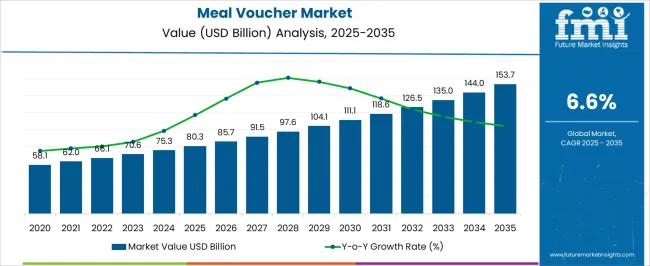
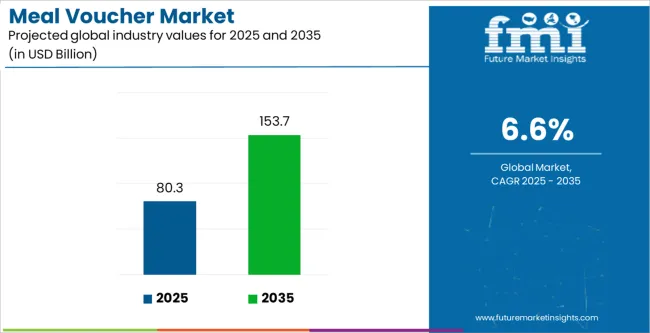
| Metric | Value |
|---|---|
| Meal Voucher Market Estimated Value in (2025 E) | USD 80.3 billion |
| Meal Voucher Market Forecast Value in (2035 F) | USD 153.7 billion |
| Forecast CAGR (2025 to 2035) | 6.6% |
The meal voucher market is expanding steadily, supported by evolving workplace benefits, growing digitization of payment systems, and increasing emphasis on employee well-being. Corporate policies across industries have recognized meal vouchers as a cost-effective tool to enhance workforce satisfaction, while governments in several regions continue to promote them through tax incentives and social welfare frameworks. Press releases from financial service providers and corporate benefit platforms have emphasized the shift toward digitalization, enabling seamless distribution, enhanced tracking, and reduced administrative burden.
The pandemic accelerated digital adoption, with employees and employers favoring contactless solutions that integrate easily with mobile wallets and POS systems. Furthermore, investor presentations from fintech companies have highlighted continuous innovation in voucher platforms, including AI-driven personalization and expanded merchant networks.
Future market growth is expected to be driven by broader employer participation, rising adoption in small and medium enterprises, and integration with health and wellness programs. The increasing dominance of digital solutions and alignment with consumer payment preferences are expected to redefine the trajectory of the market.
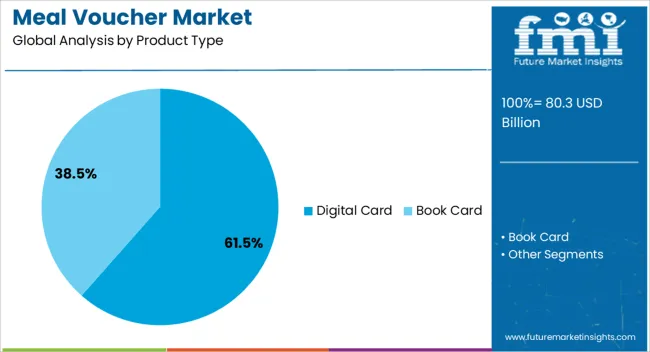
The Digital Card segment is projected to hold 61.5% of the meal voucher market revenue in 2025, cementing its position as the leading product type. This growth has been driven by the widespread shift toward digital payments and the operational efficiencies offered to employers and employees. Digital cards have reduced reliance on paper vouchers, minimizing fraud risks and improving transparency in benefit disbursement.
Corporate adoption has been supported by the ability of digital cards to integrate with payroll systems and provide employees with convenient access to funds across extensive merchant networks. Additionally, digital cards have aligned with consumer preferences for contactless transactions, particularly in urban settings where mobile and online payments are widely adopted.
Fintech innovations have expanded functionalities, such as real-time balance tracking, customizable spending categories, and automated compliance reporting for employers. These advantages, coupled with cost savings in administration and distribution, have reinforced the dominance of the Digital Card segment, which is expected to remain central to the growth of the meal voucher market.
| Historical CAGR | 8.30% |
|---|---|
| Forecast CAGR | 6.70% |
With a historical CAGR of 8.30%, this sector has proven to be a fertile ground for innovation and expansion. But as the market gazes ahead, its forecasted CAGR of 6.70% paints a portrait of evolution, a transition from the rapid tempo of yesteryears to a more measured, yet no less alluring, rhythm of growth.
The shift thus signals not a regression but rather a maturation, where stability and sustainability harmonize to set up a future feast of opportunities. The historical performance serves as a compass, guiding stakeholders through the complexities of market dynamics in this gastronomic odyssey.
It whispers tales of resilience and adaptation, reminding them of the ebbs and flows that have shaped the landscape. As the forecast beckons, it casts a spotlight on the horizon, illuminating pathways adorned with innovation and consumer-centric strategies.
The below section shows the leading segment. Based on the product type, the digital card segment is registered at a CAGR of 6.5% by 2035.
| Category | Digital Card |
|---|---|
| CAGR by 2035 | 6.5% |
Based on product type, the digital card segment stands out, registering at a CAGR of 6.5% by 2035. As technology continues to weave its threads into the fabric of everyday life, digital meal vouchers offer a seamless and agile alternative to their traditional paper counterparts.
By harnessing the power of mobile apps, online platforms, and contactless payments, users can effortlessly access, redeem, and manage their meal vouchers with a tap of their fingertips, ushering in an era of unprecedented accessibility and efficiency.
The ascent of the digital card segment is not merely a reflection of technological ability but also a response to shifting consumer expectations and behaviors. Digital meal vouchers offer unparalleled convenience and flexibility to eco-conscious consumers seeking sustainable alternatives to physical paper vouchers.
The versatility of digital platforms allows for innovative features such as personalized recommendations, budget tracking, and loyalty rewards, enhancing user engagement and loyalty.
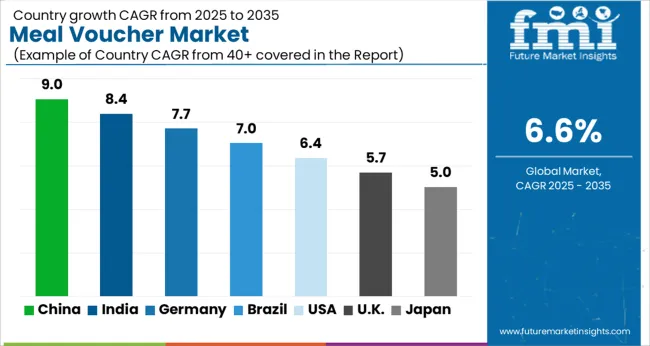
The table describes the top five countries ranked by revenue, with South Korea holding the top position. The meal voucher market dominates through widespread adoption in corporate benefits packages, incentivizing employees, and fostering workplace satisfaction.
Meal vouchers in South Korea serve as promotional tools for businesses, propelling customer engagement and bolstering the vibrant social dining culture, thus becoming an integral aspect of dining experiences.
Forecast CAGRs from 2025 to 2035
| Countries | CAGR |
|---|---|
| The United States | 7% |
| The United Kingdom | 8% |
| China | 7.5% |
| Japan | 8.5% |
| South Korea | 9% |
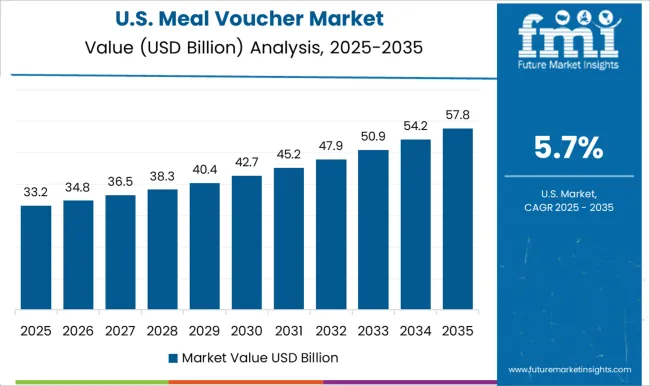
In the United States, the market is primarily used by companies as part of their employee benefits packages. Many employers offer meal vouchers as a perk to their staff, allowing them to enjoy meals at various restaurants or food establishments.
The vouchers are often distributed as part of incentive programs, employee recognition initiatives, or as a means to promote work-life balance. Meal vouchers are thus utilized by organizations to host business meetings or events, covering the cost of meals for attendees.
In the United Kingdom, meal vouchers are commonly utilized by both employers and individuals to save on dining expenses. Employers often provide meal vouchers as a tax-efficient way to support their employees' meal costs.
Individuals may also purchase meal vouchers independently or receive them as gifts, using them to dine out at restaurants, cafes, or fast-food outlets
Government agencies may also issue meal vouchers as a form of social welfare or assistance to low-income individuals or families. Businesses often use meal vouchers as promotional tools or incentives to attract customers, offering discounts or complimentary meals to encourage patronage.
With a vibrant food culture and a growing emphasis on employee welfare and consumer engagement, meal vouchers have become an integral part of the Chinese dining landscape.
In China, the market is characterized by widespread adoption across various sectors, including corporate, government, and retail. Employers commonly distribute meal vouchers to employees as part of their compensation packages or as rewards for performance.
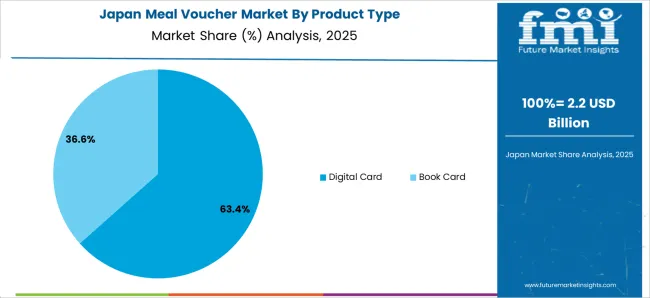
In Japan, meal vouchers are extensively utilized by companies to support employee dining expenses and foster a sense of community within the workplace. Employers commonly provide meal vouchers as a fringe benefit to employees, enabling them to enjoy meals at local restaurants, cafes, or convenience stores.
These vouchers may be distributed on a regular basis or as special bonuses during holidays or company events. Additionally, meal vouchers are often used by businesses to host client meetings or corporate gatherings, covering the cost of meals for attendees.
With a strong tradition of group dining and a culture of employee appreciation, meal vouchers play a significant role in enhancing workplace morale and fostering positive relationships among colleagues in Japan.
Businesses often use meal vouchers as promotional tools or incentives to attract customers, offering discounts or complimentary meals to drive foot traffic and a boom in sales. Consumers may also purchase meal vouchers independently or receive them as gifts, using them to dine out with friends or family members.
Employers commonly offer meal vouchers as part of their employee benefits packages, providing staff with a convenient way to enjoy meals at various dining establishments.
With a vibrant food scene and a culture of social dining, meal vouchers are an integral part of the South Korean dining experience, offering convenience and savings to both employees and consumers.
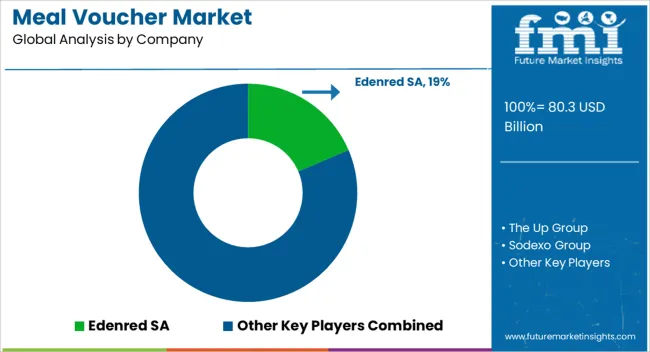
Regional players and startups also carve niches, offering specialized services or catering to specific industries. Competition intensifies as companies compete to expand acceptance networks, enhance digital offerings, and differentiate through value-added services.
Regulatory compliance, consumer preferences, and economic factors further shape the landscape, driving continuous evolution and innovation in this dynamic market.
Some of the key developments
| Attributes | Details |
|---|---|
| Estimated Market Size in 2025 | USD 75.3 billion |
| Projected Market Valuation in 2035 | USD 144 billion |
| Value-based CAGR 2025 to 2035 | 6.7% |
| Forecast Period | 2025 to 2035 |
| Historical Data Available for | 2020 to 2025 |
| Market Analysis | Value in USD billion |
| Key Regions Covered | North America; Latin America; Western Europe; Eastern Europe; South Asia and Pacific; East Asia; The Middle East and Africa |
| Key Market Segments Covered | Product Type, Region |
| Key Countries Profiled | The United States, Canada, Brazil, Mexico, Germany, The United Kingdom, France, Spain, Italy, Poland, Russia, Czech Republic, Romania, India, Bangladesh, Australia, New Zealand, China, Japan, South Korea, South Africa, Israel |
| Key Companies Profiled | Edenred SA; The Up Group; Sodexo Group; Alelo; Asinta; Axis Bank Limited; Cinqo Group; Circula GmbH; CIRFOOD International; Emburse Inc. |
The global meal voucher market is estimated to be valued at USD 80.3 billion in 2025.
The market size for the meal voucher market is projected to reach USD 153.7 billion by 2035.
The meal voucher market is expected to grow at a 6.6% CAGR between 2025 and 2035.
The key product types in meal voucher market are digital card and book card.
In terms of , segment to command 0.0% share in the meal voucher market in 2025.






Full Research Suite comprises of:
Market outlook & trends analysis
Interviews & case studies
Strategic recommendations
Vendor profiles & capabilities analysis
5-year forecasts
8 regions and 60+ country-level data splits
Market segment data splits
12 months of continuous data updates
DELIVERED AS:
PDF EXCEL ONLINE
Meal Kit Market Size and Share Forecast Outlook 2025 to 2035
Meal Tray Sealing Machines Market Size and Share Forecast Outlook 2025 to 2035
Meal Replacement Bars Market Size, Growth, and Forecast for 2025 to 2035
Meal Replacement Products Market Analysis by Product type, source, application and region Through 2035
Meal Kit Delivery Service Market - Trends & Forecast 2025 to 2035
Meal Replacement Shake Market Trends - Powder & Liquid Analysis
UK Meal Replacement Products Market Trends – Growth, Demand & Forecast 2025-2035
Oatmeal market Analysis by Nature, Type and Sales Channel Through 2025 to 2035
Fishmeal and Fish Oil Market Analysis - Size, Share, and Forecast Outlook 2025 to 2035
USA Meal Replacement Products Market Insights – Size, Share & Forecast 2025-2035
Fish Meal Alternative Market Size and Share Forecast Outlook 2025 to 2035
Fish Meal Market Analysis – Size, Share, and Forecast Outlook 2025 to 2035
Market Leaders & Share in the Fish Meal Industry
Ready Meals Packaging Market Size and Share Forecast Outlook 2025 to 2035
Vegan Meals Market Size, Growth, and Forecast for 2025 to 2035
Krill Meal Market Analysis - Size, Growth, and Forecast 2025 to 2035
Competitive Overview of Ready Meals Packaging Market Share
Blood Meal Market Analysis – Applications, Demand & Growth
Veggie Meals Market Trends - Innovation & Consumer Demand 2025 to 2035
Canola Meal Market Analysis - Size, Share & Trends 2025 to 2035

Thank you!
You will receive an email from our Business Development Manager. Please be sure to check your SPAM/JUNK folder too.
Chat With
MaRIA